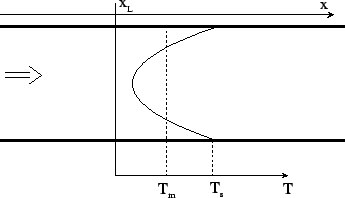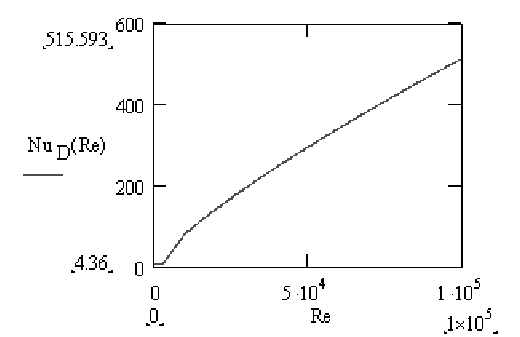Determination of the heat transfer coefficient ![]() in a
cooling tube
in a
cooling tube
A.Hormière, ST-CV, 17/08/2001
This document gives the details of the determination of the heat transfert coefficient
in a cooling tube. It allows the calculation of the temperature difference between the
mean water temperature ![]() and the inside surface temperature of the pipe
and the inside surface temperature of the pipe ![]() .
.
Introduction
When the water flows in a cooling tube, a thermal boundary layer is developing. There
is a temperature gradient between the internal surface of the pipe and the water to allow
heat transfer. There is also a gradient inside the water (Figure 1).
It is very difficult to know precisely the temperature gradient inside the water, for this
reason, we use the mean temperature value ![]() , which is the averaged value of the temperature at a
position x.
, which is the averaged value of the temperature at a
position x.
The heat transfer coefficient ![]() between
between ![]() and the inside surface temperature
and the inside surface temperature ![]() can be evaluated using correlations on
the Nusselt Number (
can be evaluated using correlations on
the Nusselt Number (![]() ) which represent the ration between convection and conduction heat transfer.
) which represent the ration between convection and conduction heat transfer.
As we know ![]() ,
we can evaluate the temperature difference between
,
we can evaluate the temperature difference between ![]() and
and ![]() for a certain heat flux
for a certain heat flux ![]() .
.

Figure1: Temperature gradient in a cooling pipe ![]() , at
, at
![]()
Correlations
Lets consider a tube of internal diameter ![]() , with a fluid flow of speed
, with a fluid flow of speed ![]() . The fluid is
characterized by its density
. The fluid is
characterized by its density ![]() , thermal capacity
, thermal capacity ![]() , thermal conductivity
, thermal conductivity ![]() and dynamic viscosity
and dynamic viscosity ![]() .
.
The Nusselt number is adimensional and defined as: ![]() . As we know
. As we know ![]() , we can
determine
, we can
determine ![]() .
.
In this type of flow, ![]() is a constant for laminar flow and a fonction of two other adimensional
numbers,
is a constant for laminar flow and a fonction of two other adimensional
numbers, ![]() and
and ![]() ,
, ![]() for turbulent flows.
for turbulent flows. ![]() depends only of the fluid used, it is defined as
depends only of the fluid used, it is defined as ![]() wher
wher ![]() is the
kinematic viscosity
is the
kinematic viscosity ![]() and
and ![]() the thermal diffusivity
the thermal diffusivity ![]() . For the water
. For the water ![]() .
. ![]() depends on the fluid an the motion
conditions,
depends on the fluid an the motion
conditions, ![]() .
.
We use the Dittus-Boelter equation from [1] for turbulent
flow (![]() ) and the value 4.36 for laminar flow (
) and the value 4.36 for laminar flow (![]() ). Between this range, we
assume a linear behavior to cover the whole range of flows. The equation is valid after a
certain length of pipe, typically 10
). Between this range, we
assume a linear behavior to cover the whole range of flows. The equation is valid after a
certain length of pipe, typically 10![]() .
.
The following equation is only valid for water, as we need to fix a ![]() to make the
linear approximation. It can easily be extended to another type of fluid.
to make the
linear approximation. It can easily be extended to another type of fluid.

When we have the ![]() , we apply:
, we apply: ![]() .
.
In the Figure 2 we can see that ![]() increases with
increases with ![]() , which means for a pipe of
a diameter
, which means for a pipe of
a diameter ![]() ,
, ![]() ie
ie ![]() increases with the speed
increases with the speed ![]() .
.

Figure2: Nusselt number fonction of Reynolds for a
water cooling pipe